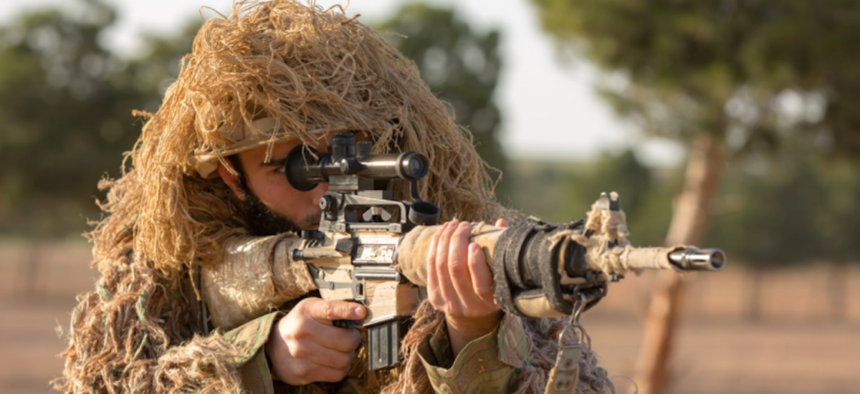
A photo of an ISIS fighter ISIS
ISIS Says Secret Weapons Await Coalition Forces In Battle for Raqqa
The terror group makes some big claims about its homegrown arsenal in the latest issue of its online magazine.
On Sunday, the Islamic State released the latest issue of its online magazine Rumiyha. In it, an ISIS military leader in Raqqa, Syria, claims to have secret weapons for use against the coalition forces that are besieging the group’s capital city.
Rumiyah, like its predecessors Dabiq and Dar al-Islam, is full of the sort of unverifiable claims and outright distortions that you might expect from a piece of propaganda fabricated by an apocalyptic death cult. But it also provides a window into the group’s stated goals and a possible showcase of future techniques.
The issue features a lengthy interview with a man identified as the “military commander of the city of Raqqa,” who said coalition forces should expect to encounter more improvised explosive devices, or IEDs, in houses, a tactic he called “among the most successful means of defense against the advance” of the coalition forces who took Mosul, Iraq, earlier this year. The commander also promises wider use of vehicle-borne IEDs — cars and trucks loaded with explosives — and claims that ISIS has segmented Raqqa into “small sections that could function individually in emergency situations and could independently pursue their objectives.” Most importantly, he says, the Islamic State might unleash “other types of weapons which Allah has bestowed upon the Mujahidin and which we have not yet revealed.”
The claim, of course, is impossible to verify independently. But the Islamic State has been experimenting with a variety of new and more deadly variations on the IED, according to Michael Cardash, a defense analyst who used to lead Israeli National Police Bomb Squad,
Speaking on Tuesday at a National Defense Industrial Association event, Cardash said that ISIS forces in Mosul had heavy use of small vehicle-borne suicide bombs, usually 4x4 trucks, armored in the front to protect the driver from fire as he accelerated toward his target. “It can run against attacking forces coming in. You will be able to see the smaller VBIEDs coming into attack the forces again and again,” he said.
More recently, ISIS bombmakers had improved on the design so that explosives in the back of the car able to detonate when the car hits a specific speed with no driver involvement, he said.
ISIS bombmakers had also extended the range of radio-frequency detonating IEDs planted in streets and in buildings. And, last November, ISIS fighters demonstrated that they could turn small drones into lethal weapons armed with rocket-propelled-grenade warheads.
Cardash expects that ISIS fighters will continue to modify small multi-rotor copters, such as the DJI Phantom 4, to become more lethal. He pointed to an incident where Hezbollah fighters — an Iranian-backed terrorist group that fights against the Islamic State on the Lebanon border— rigged a Phantom to carry four bombs rather than one. If Hezbollah could do it, presumably ISIS could as well. “We do expect the technology to expand,” he said. “The larger the payloads, the bigger the problem.”
Bomb experts have also seen ISIS begin to experiment with chemical bombs. During a March fight in Iraq’s Tel Afair region, anti-ISIS forces saw “a fixed-wing drone with a chemical canister inside probably containing chloride, which is the common chemical stuff that they use there as well. Then we saw it again in Mosul in April,” said Cardash“Haven’t actually seen it since then so either it wasn’t very successful, so they’ve left the idea of going chemical, or they are going to surprise us with something in the near future that will be a little bit more effective as well.”
Of course, ISIS has plenty of reason to lie about its ability to hang on to Raqqa. The existence of a physical capital is what gave the idea of an “Islamic State” credibility. It was the group’s base of operations from which they planned major terrorist operations such as the attacks on Brussels, Paris, and Istanbul.
Last month, Brett McGurk, special presidential envoy for the Global Coalition to Counter ISIS, said that some 25,000 Sunni-Arab fighters and some 25,000 Kurdish fighters had converged on Raqqa to liberate it from ISIS’s grip. The coalition siege of Raqqa was 40 percent finished, he said. But there was still “painstaking” work to do, block by block and room by room.
Marcus Weisgerber contributed to this report.




